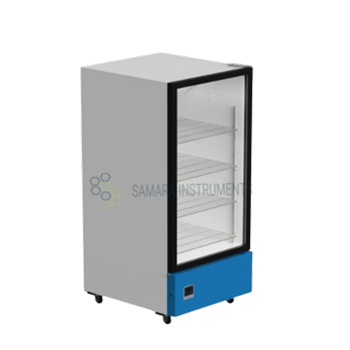


Laboratory refrigerators are a highly crucial instrument for storing various kinds of research samples, lab specimens, vaccines, medical samples, and pharmaceutical products. Read more
Laboratory refrigerators are a highly crucial instrument for storing various kinds of research samples, lab specimens, vaccines, medical samples, and pharmaceutical products. Lab refrigeration provides a controlled temperature where heat or temperature-sensitive materials can be stored for a long time. With this instrument, we can store biological specimens that are integrated and viable for a long time. Within this refrigerator, there are settings to maintain the stringent nature of the biological samples, with precise temperature-controlling systems, and integrity of the stored materials. All kinds of laboratory samples, medicines, and others are stored at 2-8 degrees celsius.
Regulatory standards of lab refrigerators:
Lab refrigerators are designed according to the regulatory standards. There are mainly three types of lab refrigerators based on regulations which are Good Laboratory Practices (GLP), Good Manufacturing Practices (GMP), and others.
Different types of lab refrigerators:
Lab refrigerators are of different types and sizes based on requirements. To store blood specimens there are specially designed refrigerators for a long time with integrity and viability. In hospitals and medical organizations, there are other types of lab refrigerators where the temperature is always set at 8 degrees Celsius. There are long-lasting qualitative materials and it is fabricated with long-lasting service life of the devices. Lab refrigerators provide temperature sensitivity through an affordable process.
Designing of the lab refrigerator:
Internal components of lab refrigerators:
Internal construction: There is a double-walled cooling unit within the lab refrigerator. Externally lab refrigerators are painted with stove enamel or elegant powders. The internal chamber is made of heavy gauge stainless steel.
Door: The doors of the lab refrigerator are made of galvanized steel sheets. The single door is fitted with a gasket system to protect temperature loss and maintain a controlled temperature within the instrument. This door is locked with a multichannel door lock system for safety purposes.
Cooling unit: Nowadays lab refrigerators are equipped with a highly efficient cooling unit in the mortuary chamber. Mostly there is a cold compressor unit which is of Kirloskar or ISI marked. It has no environmental effect with CFC or other greenhouse gasses.
Temperature controlling system: There is a microcontroller electronic temperature controlling system with an LED display. Here the accuracy of the temperature is 0.1 degrees celsius.There are various alarm systems to make people cautious about temperature fluctuations. It provides temperature uniformity and stability.
Control panel: There is a digital control panel system with external power on-off options with a sensor error alarm. There is a voltage system with backup systems.
With all of these features, lab refrigerators are a great part and parcel of laboratories, research institutes, and other industries.
|
Specification |
|
|
|
|
|
Temperature
Control |
|
|
|
|
|
Temperature
range |
2°C
to 8°C |
|
Temperature
Accuracy |
±
1°C |
|
Readability |
0.1
°C |
|
Temperature
Sensor |
PT-100 |
|
Temperature
Controller |
PID
Controller |
|
Display |
LED/LCD |
|
|
|
|
Safety
thermostats |
|
|
|
|
|
Temperature
variation Adjustments |
3
(With PID Controllers only) |
|
Automatic
temperature setting |
Yes
(With PID Controllers only) |
|
Adjustable
limits |
Yes
(With PID Controllers only) |
|
Air
Circulation |
Forced |
|
Refrigerant |
R134A
Non CFC |
|
|
|
|
Power
consumption |
|
|
|
|
|
Nominal
voltage |
220-234
Volts, 50 Hz Single Phase |
|
Frequency |
50
Hz |
|
Optional |
Automatic
Voltage Stabilizer |
|
|
|
|
Model
No. |
Volume
(Liters) |
|
SI -
LR/100 |
100 |
|
SI -
LR/153 |
153 |
|
SI -
LR/270 |
270 |
|
SI -
LR/400 |
400 |
|
SI -
LR/500 |
500 |
|
SI -
LR/1000 |
1000 |
|
SI -
LR/1175 |
1175 |
|
SI -
LR/1500 |
1500 |
|
SI -
LR/2000 |
2000 |
